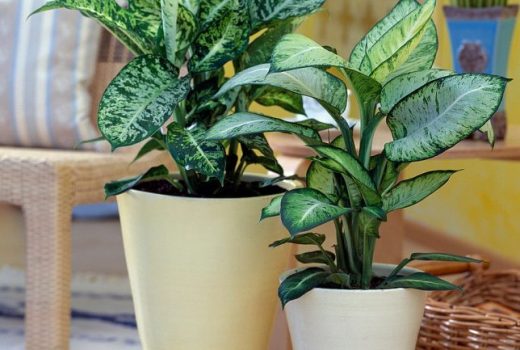Dieffenbachia is an incredible tropical houseplant which is commonly known as the “Dumb Cane”. These large and showy plants are perfect options for home and office decoration.
However, you shouldn’t grow these plants at a place with small children or curious pets due to its toxic sap. It is a poisonous plant that irritates when ingested. Therefore, be careful when planting the dieffenbachia plant.
Dieffenbachia care is not that difficult which makes it the best choice for new gardeners. This article shares some useful tips on common care ways. Let’s get started…
Dieffenbachia Care Instructions – Also known as Dumb Cane Plant
It is a hardy plant that can last for a long period. In terms of requirements, it is one of the easiest plants to grow. You can grow it whenever you want without looking for a special month and season.
If you want to keep your plants healthy, you need to take care of a few things as follows:
Ideal Soil for Dieffenbachia Care
Soil is the most important factor of dieffenbachia care. Potting mix can be one of the best options. You can use one part all-purpose loam, one part peat moss, and one part sharp sand. You can mix perlite or vermiculite with sharp sand.
If you want to grow the plants outdoors, you should use an open shaded patio. When you grow the plants indoors, you can purchase houseplants soil for better results. You can make potting soil yourself by adding two parts peat moss and 1 part perlite.
The Best Temperature for Dieffenbachia Plants
The average room temperature for dieffenbachia plants is between 65 to 75 degrees Fahrenheit. They can’t tolerate low temperatures. Temperature below 60o F slows down the growth of the plants.
Some varieties of dieffenbachia are severely damaged by cold when the temperature falls below 55o F. Similarly, too high a temperature and bright light can also make the plants weak and sickly.
Watering Dieffenbachia Plants
Being a member of the aroid family, dieffenbachia plants like humidity. These plants don’t require frequent watering. There is no fixed schedule for watering the plants. For example, plants need more watering during the summer and less during wintertime.
Location, time of year, lighting, humidity, and, soil are different factors that contribute to how often you should water the plants. If humidity is high, reduce watering. If the temperature is high, increase watering. You should water the plants when the soil is dry. Wait after watering the plants until the soil dries out before watering the plants again.
Overwatering can be a cause of root rot, weak growth, and stems might become mushy. Similarly, less watering can also affect the growth of the plants. Therefore, always water the plant when necessary.
How to Fertilize Dieffenbachia?
First and foremost, you need to choose a suitable fertilizer for the plants. You should choose a balanced water-soluble liquid houseplant fertilizer for these plants. Then, reduce half of its strength before using that for dieffenbachia care.
You should choose the most common liquid houseplant fertilizer such as Miracle-Gro. Then, mix half of its tablespoon to one gallon of water when using. It is good to fertilize the plants when watering. You should add fertilizer during the summer. Don’t frequently fertilize the plants in the winter months.
Dieffenbachia Pests and Diseases
Many new gardeners ask “why is my dieffenbachia leaves turning yellow”. There are some reasons for yellowing leaves such as:
If the entire plant is healthy and has a few yellow leaves showing up throughout the years, those are most possibly old leaves. The growing of new leaves and the falling of old leaves is normal in all plants.
If more leaves are dying off, it can be a more serious problem. There are several similar issues like curled leaves, plant rotting, bleached foliage, brown tips on the leaves, and weak new growth.
Are you experiencing such issues? If so, overwatering will be the main issue. Get rid of all issues, you should stop watering the plants. Don’t water the plants until the soil dries out completely.
Follow the instructions below to get rid of such issues:
- Remove the plant from the pot and examine the roots carefully.
- Roots should be free from all diseases and white.
- If you find any damaged root, remove that.
After removing affected or unwanted roots, you should plant that again in the right soil. After planting the dieffenbachia, remove all damaged and bad leaves. After pruning the plant, it is good to place the plant in a well-ventilated area for dieffenbachia care.


2 Responses
I had to move my Dieffenbachia to an area of the house that sometimes gets diffused light. Sometimes it gets very little light. Will a normal overhead light bulb, provide enough light for it to remain healthy?
Dieffenbachia plants generally prefer bright, indirect light, but they can tolerate lower light conditions to some extent. While a normal overhead light bulb may provide some light for your Dieffenbachia, it may not be sufficient for its optimal growth and health.